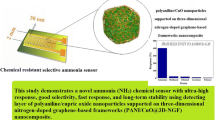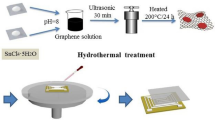Abstract
Indium trioxide (In2O3) nanoparticles prepared using a solvothermal reaction were coated on the surface of graphene nanoribbon (GNR) to serve as a core for the manufacture of polyaniline (PANI)/In2O3/GNR ternary nanocomposites produced using in situ chemical oxidative polymerization. The gas-sensing properties of nanocomposites were evaluated by a homemade dynamic test system at room temperature, which was equipped with a real-time resistance acquisition platform. The response value of the PANI/In2O3/GNR sensor with the loading of 3 wt% In2O3 nanoparticles and an exposure of 4 ppm NH3 was 27.1, which was about 3 or more times higher than that of PANI sensor. This sensor was shown to be very sensitive to the detection of NH3 in the concentration range of 0.65–1.69 ppm at room temperature, which is critical in the detection of hepatic or kidney disease in the human breath. The PANI/In2O3/GNR sensor also revealed higher selectivity and repeatability when exposed to 0.65 ppm NH3 at room temperature. Because of the excellent selectivity and repeatability in the detection of 0.65 ppm NH3 at room temperature obtained in this report, it is believed that the PANI/In2O3/GNR nanocomposites sensor will be a promising gas-sensing material for the detection of hepatic or kidney disease in human breath.









Similar content being viewed by others
References
M. Phillips, J. Herrera, S. Krishnan, M. Zain, J. Greenberg, R.N. Cataneo, Variation in volatile organic compounds in the breath of normal humans. J. Chromatogr. B 729, 75–88 (1999)
M. Phillips, R.N. Cataneo, A.R.C. Cummin, A.J. Gagliardi, K. Gleeson, J. Greenberg, R.A. Maxfield, W.N. Rom, Detection of lung cancer with volatile markers in the breath. Chest. J. 123, 2115–2123 (2003)
H. Haick, Y.Y. Broza, P. Mochalski, V. Ruzsanyi, A. Amann, Assessment, origin, and implementation of breath volatile cancer markers. Chem. Soc. Rev. 43, 1423–1449 (2014)
A. Wehinger, A. Schmid, S. Mechtcheriakov, M. Ledochowski, C. Grabmer, A. Amann, Lung cancer detection by proton transfer reaction mass-spectrometric analysis of human breath gas. Int. J. Mass Spectrom. 265, 49–59 (2007)
R. Capuano, M. Santonico, G. Pennazza, S. Ghezzi, E. Martinelli, C. Roscioni, G. Lucantoni, G. Galluccio, R. Paolesse, C.D. Natale, A. D’Amico, The lung cancer breath signature: a comparative analysis of exhaled breath and air sampled from inside the lungs. Sci. Rep. 5, 16491 (2015)
B. Grabowska-Polanowska, J. Faber, M. Skowron, P. Miarka, A. Pietrzycka, I. Sliwka, A. Amann, Detection of potential chronic kidney disease markers in breath using gas chromatography with mass-spectral detection coupled with thermal desorption method. J. Chromatogr. A 1301, 179–189 (2013)
S. Davies, P. Spanel, D. Smith, Quantitative analysis of ammonia on the breath of patients in end-stage renal failure. Kidney Int. 52, 223–228 (1997)
C. Turner, P. Španěl, D. Smith, A longitudinal study of ammonia, acetone and propanol in the exhaled breath of 30 subjects using selected ion flow tube mass spectrometry SIFT-MS. Physiol. Meas. 27, 321 (2006)
L.K. Buckley, G.E. Collins, Conductive polymer-coated fabrics for chemical sensing. Synth. Met. 78, 93–101 (1996)
G. Ciric-Marjanovic, Recent advances in polyaniline research: Polymerization mechanisms, structural aspects, properties and applications. Synth. Met. 177, 1–47 (2013)
M. Eising, C.E. Cava, R.V. Salvatierra, A.J.G. Zarbin, L.S. Roman, Doping effect on self-assembled films of polyaniline and carbon nanotube applied as ammonia gas sensor. Sens. Actuators B 245, 25–33 (2017)
L. Xue, W. Wang, Y. Guo, G. Liu, P. Wan, Flexible polyaniline/carbon nanotube nanocomposite film-based electronic gas sensors. Sens. Actuators B 244, 47–53 (2017)
C. Liu, H. Tai, P. Zhang, Z.X. Yuan Du, G. Xie, Y. Jiang, A high-performance flexible gas sensor based on self-assembled PANI-CeO2 nanocomposite thin film for trace-level NH3 detection at room temperature. Sens. Actuators B 261, 587–597 (2018)
S. Li, P. Lin, L. Zhao, C. Wang, D. Liu, F. Liu, P. Sun, X. Liang, F. Liu, X. Yan, Y. Gao, G. Lu, The room temperature gas sensor based on polyaniline@flower-like WO3 nanocomposites and flexible PET substrate for NH3 detection. Sens. Actuators B 259, 505–513 (2018)
C.W. Na, J.H. Kim, H.J. Kim, H.S. Woo, A. Gupta, H.K. Kim, J.H. Lee, Highly selective and sensitive detection of NO2 using rGO-In2O3 structure on flexible substrate at low temperature. Sens. Actuators B 255, 1671–2167 (2018)
H.P. Oliveira, S.A. Sydlik, T.M. Swager, Supercapacitors from free standing polypyrrole/graphene nanocomposites. J. Phys. Chem. C 117, 10270–10276 (2013)
L. Li, A.R.O. Raji, H.L. Fei, Y. Yang, E.L.G. Samuel, J.M. Tour, Nanocomposite of polyaniline nanorods grown on graphene nanoribbons for highly capacitive pseudocapacitors. ACS Appl. Mater. Interfaces 5, 6622–6627 (2013)
M.K. Liu, W.W. Tjiu, J.S. Pan, C. Zhang, W. Gao, T.X. Liu, One-step synthesis of graphene nanoribbon–MnO2 hybrids and their all-solid-state asymmetric supercapacitors. Nanoscale 6, 4233–4242 (2014)
D. Zhang, Z. Wu, P. Li, X. Zong, G. Dong, Y. Zhang, Facile fabrication of polyaniline/multi-walled carbon nanotubes/molybdenum disulfide ternary nanocomposite and its high-performance ammonia-sensing at room temperature. Sens. Actuators B 258, 895–905 (2018)
X. Huang, N. Hu, R. Gao, Y. Yu, Y. Wang, Z. Yang, E.S.W. Kong, H. Wei, Y. Zhang, Reduced graphene oxide-polyaniline hybrid: preparation, characterization and its applications for ammonia gas sensing. J. Mater. Chem. 22, 22488 (2012)
H. Tai, X. Xu, Z. Ye, C. Liu, G. Xie, Y. Jiang, P-P heterojunction sensor of self-assembled polyaniline nano-thin film/microstructure silicon array for NH3 detection. Chem. Phys. Lett. 621, 58–64 (2015)
Z. Pang, Q. Nie, A. Wei, J. Yang, F. Huang, Q. Wei, Effect of In2O3 nanofiber structure on the ammonia sensing performances of In2O3/PANI composite nanofibers. J. Mater. Sci. 52, 686–695 (2016)
Z. Pang, J. Yu, D. Li, Q. Nie, J. Zhang, Q. Wei, Free-standing TiO2–SiO2/PANI composite nanofibers for ammonia sensors. J. Mater. Sci. Mater. Electron. 29, 3576–3583 (2017)
X. Wang, S. Meng, M. Tebyetekerwa, W. Weng, J. Pionteck, B. Sun, Z. Qin, M. Zhu, Nanostructured polyaniline/poly(styrene-butadiene-styrene) composite fiber for use as highly sensitive and flexible ammonia sensor. Synth. Met. 233, 86–93 (2017)
Y. Qin, L. Wang, X. Wang, A high performance sensor based on PANI/ZnTi-LDHs nanocomposite for trace NH3 detection. Org. Electron. 66, 102–109 (2019)
S. Mousavi, K. Kang, J. Park, I. Park, A room temperature hydrogen sulfide gas sensor based on electrospun polyaniline–polyethylene oxide nanofibers directly written on flexible substrates. RSC Adv. 6, 104131–104138 (2016)
D. Zhang, Z. Wu, X. Zong, Metal-organic frameworks-derived zinc oxide nanopolyhedra/S, N: graphene quantum dots/polyaniline ternary nanohybrid for high-performance acetone sensing. Sens. Actuators B 288, 232–242 (2019)
Acknowledgements
The financial support for this work is provided by the Ministry of Science and Technology (MOST) under Grand MOST 108-2212-E-005-006 and the Ministry of Education under the project of Innovation and Development Center of Sustainable Agriculture (IDCSA).
Author information
Authors and Affiliations
Corresponding author
Additional information
Publisher's Note
Springer Nature remains neutral with regard to jurisdictional claims in published maps and institutional affiliations.
Rights and permissions
About this article
Cite this article
Xu, LH., Wu, TM. Synthesis of highly sensitive ammonia gas sensor of polyaniline/graphene nanoribbon/indium oxide composite at room temperature. J Mater Sci: Mater Electron 31, 7276–7283 (2020). https://doi.org/10.1007/s10854-020-03299-6
Received:
Accepted:
Published:
Issue Date:
DOI: https://doi.org/10.1007/s10854-020-03299-6




